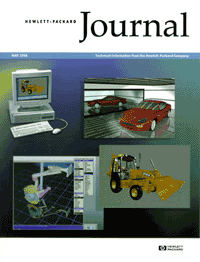 Technical computing today is increasingly dominated
by design and analysis tasks that require high-performance workstation and software products. Some of the products
described in this issue address the needs of this emerging market.
Technical computing today is increasingly dominated
by design and analysis tasks that require high-performance workstation and software products. Some of the products
described in this issue address the needs of this emerging market.
On the software side, we have the DirectModel 3D modeling toolkit and the HP implementation of the OpenGL®
graphics standard. The toolkit provides application developers with the capability to develop applications that
can construct 3D models containing millions or billions of polygons. DirectModel is built on top of the HP OpenGL
product. OpenGL is a vendor-neutral, multi-platform, industry-standard application programming interface (API)
for developing 2D and 3D visual applications.
For running these applications, we have the HP Kayak PC-based workstation running the Windows® NT operating
system. HP Kayak provides world-leading 3D graphics performance typically found in high-end UNIX® workstations.
Much of the hardware architecture for HP Kayak is based on the VISUALIZE fx 4 graphics accelerator, which is designed
to provide native acceleration for the OpenGL API.
A common theme underlying the development of all these products is the desire to shorten the time to market. Concurrent engineering was employed in the OpenGL project to achieve this goal. Processes done in serial were modified to be done in parallel, shortening the product development cycle. Quality engineers at the HP Kobe Instrument Division reengineered their quality assurance process to deal with the time-to-market issue and still maintain high-quality released software.
We have two articles about HP-UX workstations. One describes a feature that allows multiple monitors to be configured as one contiguous viewing space, and the other discusses the challenges of adding the Peripheral Component Interconnect, or PCI, to HP B-class and C-class workstations.
Information is the fuel that drives today's enterprises. Thus, we have three articles that discuss the use of information to do such tasks as linking business manufacturing software to the factory floor, providing a knowledge database for support personnel, and forecasting component demand in material planning.
The article about HP VEE (Visual Engineering Environment) is an example of our new publishing paradigm of using the web to extend or complement what appears in the printed version of the Hewlett-Packard Journal.
C. L. Leath
Managing Editor
|